Labroidei
There's a bunch of skeletal features that unite this suborder, but I won't bore you with that. Instead, let's talk about protogyny. Most species in Labridae and Scaridae are protogynous, meaning that they can transition from female to male. Often there is a large male with a harem of females. When the male dies, the largest female changes to male and takes over. This makes sense from an evolutionary perspective in some environments, because it helps to maximize the number of offspring produced.

By Jonas Engler (Own work) [CC BY-SA 3.0 or GFDL], via Wikimedia Commons

By Keven Law from Los Angeles, USA (Flickr: Angel of the North [CC BY-SA 2.0], via Wikimedia Commons
Cichlidae: Cichlids
This is one of the largest families of fishes, containing 112 genera and more than 1300 species. One uniting feature is the presence of an interrupted lateral line, another being the fusion of the pharyngeal bones into a single structure. There is variation in body shape from rounded to high, and even more variation in the size of fins. Cichlids are famous for the vast number of species present together in African lakes, specifically Malawi, Victoria, and Tanganyika. They have been extensively studied in all aspects of their lifestyles, to better understand the evolutionary process behind speciation. Cichlids are also popular aquarium fishes.
- Tilapia (Tilapia, Sarotherodon, and Oreochromis): These are commonly known for being good food fishes, and are also used because they eat unused food in ponds and get rid of environmental pollutants, making the water better for other species to survive in.
- Angelfish (Pterophyllum): Not to be confused with Pomacanthids, these are freshwater angelfishes. They have a triangular body shape with high sail-like fins. They are popular aquarium fishes.
- Discus (Symphysodon): These fishes have a more rounded body plan, with large symmetrical dorsal and anal fins. They are also popular aquarium fishes.
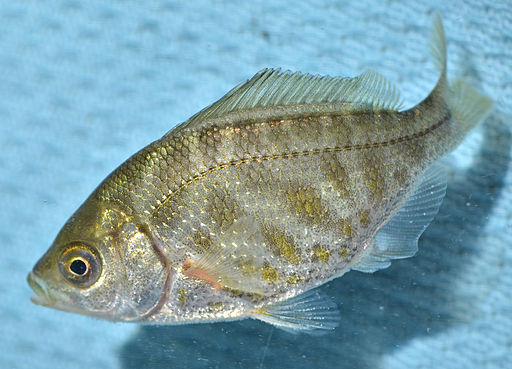
By Donald J. Loarie (Donald J. Loarie) [CC BY-SA 3.0], via Wikimedia Commons
Embiotocidae: Surfperches
Fishes aren't usually known for giving live birth, but you've probably already figured out that there's an exception to every rule. The surfperches are viviparous, meaning they give birth to live young. The male impregates the female by using the thickened end of the anal fin. Although the embryos don't have placentas, there may be some connection to the mother for nutritional support.
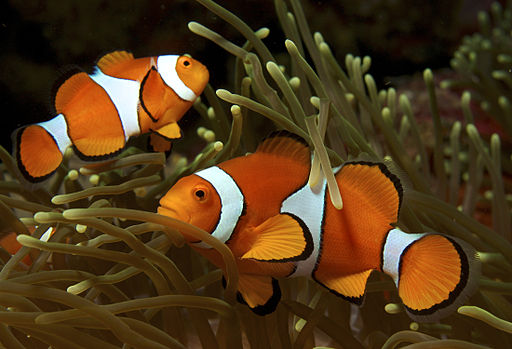
By Nick Hobgood (Own work) [CC BY-SA 3.0], via Wikimedia Commons
By Uxbona (Own work) [CC BY-SA 3.0], via Wikimedia Commons
Pomacentridae: Damselfishes
Many snorkelers and divers are familiar with these tiny colorful fishes constantly swimming around and occasionally protecting their eggs. They often lay patches of eggs that look like colored sand, and the male is tasked with standing guard. Some damselfishes are quite famous.
- Clownfish (Amphiprioninae): Yes, you found Nemo. The fishes in this subfamily live in and around sea anemones for protection, not being stung by the pneumocysts. It is possible they provide some benefit in the form of dropping food, but it is unknown how much of a role this actually plays.
- Sergeant major (Abudefduf saxatilis): These fishes are commonly seen while diving, and are extremely protective of their eggs. I find them interesting because the genus name is Arabic for "the one with prominent sides," making them unique among the many Latin names. The sides have black vertical stripes, and the dorsal area is often colored yellow.
- Garibaldi (Hypsypops rubicundus): Reddish in color, this species is named after Giuseppe Garibaldi due to his followers wearing red shirts. It is the state fish of California.
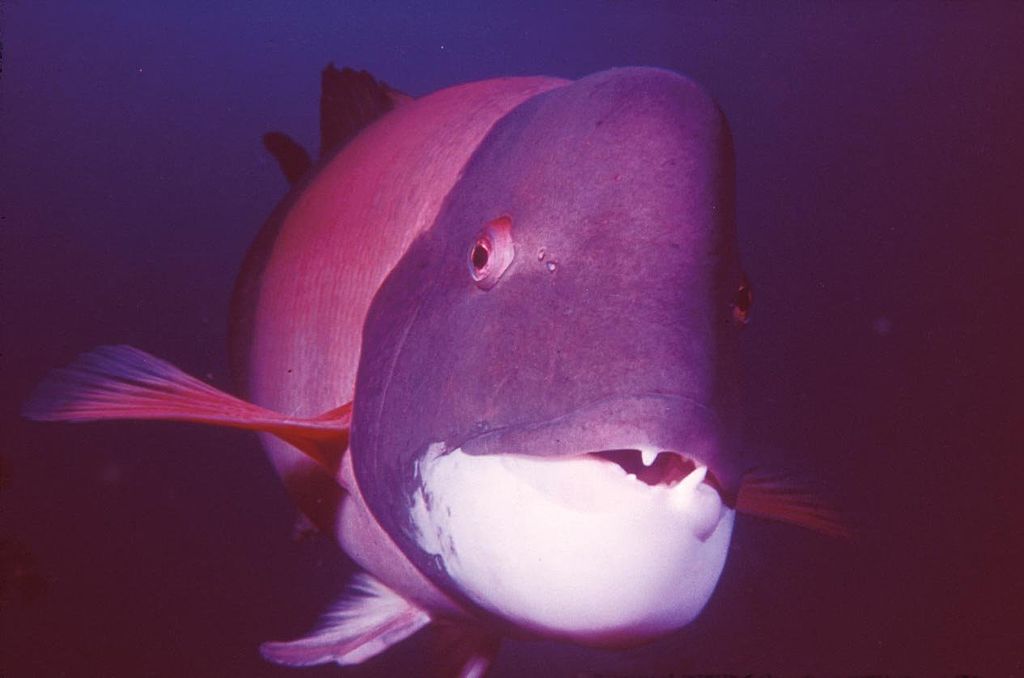
http://sanctuaries.noaa.gov/pgallery/pgchannel/living/living_28.html
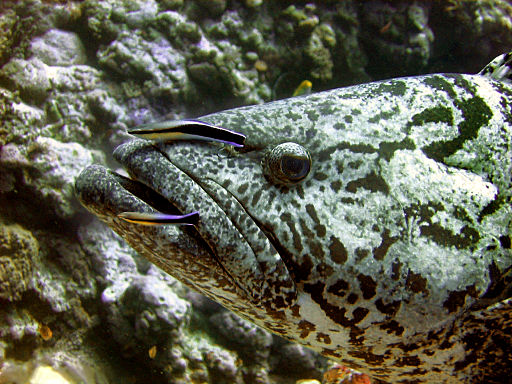
By Richard Ling (Flickr) [CC BY-SA 2.0], via Wikimedia Commons
Labridae: Wrasses
This is one of the largest families of fishes, containing 68 genera with over 450 species. They are extremely colorful and come in a variety of sizes and shapes. They have jaw teeth and like to bury themselves in the sand at night.
- California sheephead (Semicossyphus pulcher): This species is often used as a good example of protogyny, meaning it starts life as a female but the largest fish in the population can morph into a male, in order to increase its reproductive success. Males are noticable with a orange midbody and a large forehead.
- Tautog (Tautoga onitis): The only member of its genus, it is a good food fish and is often seen by divers. There have been two USS Tautogs, both submarines.
- Slingjaw wrasse (Epibulus insidiator): This wrasse gets its name from its protrusible jaw, which forms a tube with which it can suck up prey. HERE is a video of it on a reef, and HERE is a video of it being filmed in a lab.
- Blue Gropers (Achoerodus): Don't get too close to these fishes when you're diving, otherwise they'll come grope you! This genus is the state fish of New South Wales in Australia.
- Bluestreak Cleaner Wrasse (Labroides dimidiatus): Cleaner wrasses are known for eating dead tissue and parasites off larger fishes, with the most wellknown being the bluestreak. Although the perfect size for prey, the larger fish do not eat the cleaner wrasses (probably because it's better to have parasites removed than to get a small meal). Cleaner fishes are recognized by a stripe along the body as well as specific bodily motions. A 1995 paper by Robert Poulin entitled "Cleaning symbiosis as an evolutionary game" gives an interesting look at the method through which cooperative cleaning could have evolved.
- Slippery dick (Halichoeres bivittatus): Yeah, someone actually named a fish "slippery dick." Who comes up with these names? They should either be fired or promoted.
- Puddingwife wrasse (Halichoeres radiatus): Another strangely named fish. I have no idea what a puddingwife is, or what a puddinghusband would look like.
- Humphead Wrasse (Cheilinus undulatus): This species is recognizable by the prominent hump on larger individuals of both sexes.
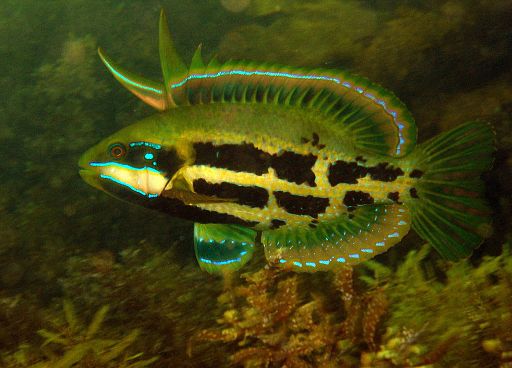
By Richard Ling (Flickr) [CC BY-SA 2.0], via Wikimedia Commons
Odacidae: Cales
The opposite of the slingjaw wrasse, these fishes have a nonprotractile jaw. Some look similar to parrotfish, while others have a more elongate body. Siphonognathus argyrophanes is much more elongate and does not look very similar to other members, looking more similar to a trumpetfish.
By User:Rling derivative work: User:IdLoveOne (Bicolor_parrotfish.JPG) [CC BY-SA 3.0], via Wikimedia Commons
Scaridae: Parrotfishes
This family of fishes is named because their fused teeth form a beak, attached to a nonprotractile jaw. They can be both seen and heard on coral reefs as they munch on dead coral. Much of the surrounding sand began life as parrotfish poop. Some species produce an envelope of mucus to cocoon themselves at night, probably as a predator deterrent. Parrotfish are extremely recognizable by their bright colors, which help differentiate different species from each other.